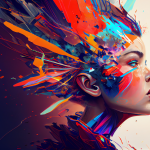Introduction.
Artificial intelligence has come a long way, and one of its coolest applications is generating stunning images from scratch.
AI image generators are no longer just high-tech novelties—they’re tools that artists, designers, and even businesses are using to bring ideas to life.
Building your own AI image generator website can be a rewarding project, offering both creative possibilities and practical uses.
Why Building an AI Image Generator Website Matters
AI image generation isn’t just a trend. It’s transforming industries like art, advertising, and content creation.
Platforms like DALL·E 2 and MidJourney have shown how AI can turn simple text descriptions into unique visuals.
However, relying on third-party services has limitations. Owning your platform gives you full control over features, customization, and branding.
There’s also a growing market for these tools. According to Statista, the global AI market is projected to reach $126 billion by 2025.
With AI-driven creativity on the rise, a well-designed image generator website can open doors to business opportunities, learning experiences, or just a fun side project.
How Do I Build an AI Image Generator Website?
Here’s a straightforward breakdown of how you can create your site, even if you’re not a tech expert.
1. Understand the Basics of AI Image Generation
AI image generation typically works using machine learning models like Generative Adversarial Networks (GANs) or diffusion models.
These systems are trained on large datasets of images and learn to create new visuals based on patterns.
You don’t need to train your model (it’s complex and requires a lot of computing power). Instead, you can use pre-trained models like:
- Stable Diffusion (open-source and flexible)
- DALL·E (API available for integration)
- RunwayML (easy-to-use tools for creators)
2. Choose Your Tools and Frameworks
You’ll need some basic tools to get started:
- Frontend Development: Use HTML, CSS, and JavaScript for designing the user interface. Frameworks like React or Vue.js can help make your site interactive.
- Backend Development: Python is a great choice here. Frameworks like Flask or Django can handle your API and server-side logic.
- AI Model Integration: You can use APIs like OpenAI’s DALL·E or integrate a library like Hugging Face’s Transformers.
3. Set Up Your Backend
Your backend is the engine that powers the site. Here’s what to do:
- Install Python and Necessary Libraries: For example:
pip install flask requests transformers - API Integration: If you’re using a pre-trained model API, write a Python script to send requests and retrieve results.
- Generate Images: Create a route in Flask to handle user inputs (like text prompts) and return the generated images.
4. Design the Frontend
Your website’s frontend is what users interact with. Keep it simple and intuitive. Some features you might include:
- Text Input Box: For users to type prompts (e.g., “a futuristic cityscape at sunset”).
- Generate Button: Triggers the backend to create an image.
- Image Display Area: Shows the generated result.
Using JavaScript, you can connect the frontend to your backend with an API call. Here’s a basic example using Fetch:
fetch('http://your-backend-url.com/generate', {
method: 'POST',
headers: {
'Content-Type': 'application/json',
},
body: JSON.stringify({ prompt: userPrompt }),
})
.then(response => response.json())
.then(data => displayImage(data.imageUrl));5. Host Your Website
To make your site accessible online, you’ll need hosting:
- Frontend Hosting: Platforms like Netlify or Vercel are free and simple to use.
- Backend Hosting: Services like AWS, Google Cloud, or Heroku can host your Python server.
- Domain Name: Get a memorable domain from providers like GoDaddy or Namecheap.
6. Add Features for a Better Experience
- User Accounts: Allow users to save prompts and generated images.
- Customization Options: Let users choose styles, resolutions, or other preferences.
- Monetization: Offer premium features, such as higher-quality images or faster processing, for a fee.
FAQs
1. Do I need coding skills to build this website?
Basic knowledge of coding is helpful, but you don’t need to be an expert. You can use tools like RunwayML for no-code solutions or hire a developer if needed.
2. Are there free AI models available?
Yes! Stable Diffusion and Hugging Face both offer free, open-source models.
3. How much will it cost?
If you use free tools and host your site on a budget-friendly platform, you could spend under $100. Adding premium features or custom models might cost more.
4. What about legal issues?
Make sure you check the licensing for the AI model you use. Some models or datasets have restrictions on commercial use.
Conclusion
Creating an AI image generator website is an exciting way to dive into AI technology and bring your ideas to life.
Whether you’re building it as a fun project, a portfolio piece, or a full-fledged business, it’s an opportunity to learn new skills and explore cutting-edge tech.
What kind of features would you like to add to your AI image generator website?





GIPHY App Key not set. Please check settings